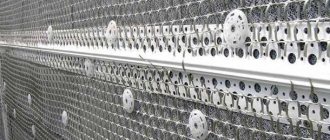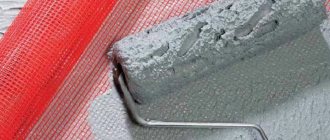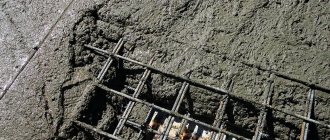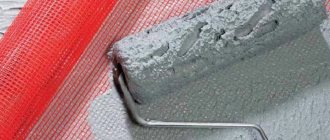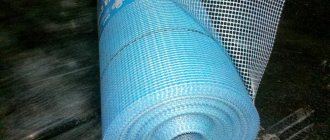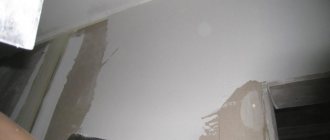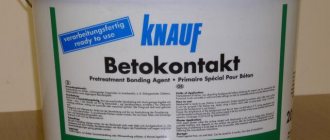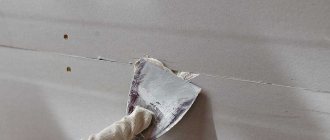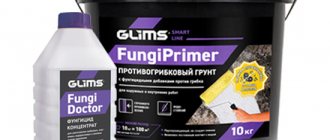Plastering the facade over insulation is used to level the surface of the structure, improve the technical properties of the material and protect it from the negative effects of the environment. Polystyrene foam, which is used for cladding buildings, has good thermal insulation properties, but at the same time it is fragile and short-lived. Mesh for plastering walls is a special building material that is made from various types of reinforcement with different cell sizes.
Purpose of reinforcing materials on the wall for plastering work
Plaster reinforcement is an effective, time-tested technology for improving the characteristics of a leveling coating.
Painting mesh for plaster performs the following functions:
- Helps create a coating layer of greater thickness than specified by the manufacturer. This allows you to solve the problem of uneven walls. Sometimes, to create a uniform and smooth surface, it is necessary to apply more mortar than the structure can withstand.
- Creates conditions for the formation of a solid layer, protects it from shrinkage cracks and their consequences. This is especially important for finishing ceilings, door and window openings. The reinforced mesh helps prevent peeling and subsequent collapse of the finish.
- Increases the durability of the finishing layer. Thanks to the mesh, the coating can withstand heavy loads. For example, this is important if cabinets or heavy shelves for books and other items are mounted on the wall. Thanks to the reinforcing layer, the load on the wall is reduced.
Reinforcement is subject to a solution of any composition whose thickness exceeds 3 cm.
Cases when you need a façade mesh for plaster:
- when performing work with a large thickness of the mixture - partially or over the entire base;
- if the building is located close to other buildings and complexes, which, in turn, have a vibration effect on it;
- if neighboring premises have undergone redevelopment and the specific weight of the structure has been redistributed;
- to modify the initial durability characteristics of the coating - increases the load-bearing capacity for placing attached household equipment and furniture.
Why is plaster reinforcement needed, what function does it serve?
If you apply the mixture in the usual way, it will take a lot of time for pre-layer drying. Plaster on a mesh is applied faster, immediately over the entire thickness of the coating. The cells keep the composition stationary; they divide the common layer into many components. The strength of plaster on walls if a mesh is installed is much higher; it is not afraid of accidental impact loads. The mesh forms a monolithic slab.
With reinforcement, the alignment of walls is easier, the thickness of the reinforcing layer is fixed. When using a mesh, deviations from the recommended moisture content of the mortar will go unnoticed. The risk of cracking is minimal.
Types of reinforcing mesh for walls
The mesh for finishing work acts as a frame that holds the entire structure from destruction.
Before using reinforcement, other building materials were also tested. Experts wanted to get strength, high adhesion, elasticity and durability from them. However, not all options survived testing. Special requirements are imposed on materials that are used for exterior finishing, because... Temperature changes, moisture and other climatic factors have a negative impact on the surface.
The following meshes are most often used for plastering facades:
- metal;
- fiberglass;
- polyurethane;
- fiberglass;
- lavsan;
- from modified basalt glass (only for wooden surfaces).
Metal construction reinforced mesh
Iron reinforcing material is produced in various variations. Each modification has its own characteristics and technical features.
Plaster mesh is distinguished according to the following characteristics:
- by weaving method and cell sizes;
- by the thickness of the rods and the method of processing them;
- according to composition and production method.
The advantages of metal reinforcing material include:
- high strength;
- possibility of use with any type of mortar and base (concrete, cement, clay, wood, etc.);
- strengthening effect on a layer of any thickness;
- the ability to cut the canvas with metal scissors or simple wire cutters;
- the ability to withstand foundation shrinkage and vibration from neighboring buildings.
The disadvantages included:
- the heavy weight of the iron sheet, because of this it cannot be used to reinforce thin walls or drywall;
- the ability of uncoated iron to deteriorate due to corrosion.
Metal mesh for reinforcing plaster is divided into several types:
- All metal expanded metal
. For its production, sheet material with a thickness of about 0.4-0.5 mm is used, in which cells are made in a checkerboard pattern. The resulting pattern is then stretched until it reaches a height of 1 mm and a width of 3 mm.
- Cold rope or galvanized
. During the manufacturing process, wires of the same thickness are intertwined. The cells will be in the shape of a rhombus or scales.
- Chainlink
- began to be called so in honor of its inventor Karl Rabitz, who patented it at the end of the 19th century. It is characterized by high strength, because the elements are connected to each other by welding.
Why do you need a basalt mesh?
Plaster with mesh will last longer and help protect the insulation from the negative effects of the environment. Basalt reinforcement appeared relatively recently and in terms of strength and reliability has surpassed fiberglass material, which for a long time occupied a leading position. Basalt reinforced mesh is resistant to ultraviolet rays and alkaline environments, and provides good adhesion to putty and plaster.
Due to its technical properties, it is often used to strengthen the base and load-bearing walls indoors. The width of the canvas is from 0.5 m to 5 m, the cell size is from 5 to 25 mm.
Why do we need fiberglass mesh?
Fiberglass mesh for facades under plaster is durable and elastic. It is obtained by melting aluminoborsilicate glass. The material is sold in rolls 1 m wide and 1 m long. For exterior finishing work, fabric with cells of 2, 5 and 10 mm is most often used.
The positive characteristics of fiberglass mesh include:
- fire resistance;
- light weight;
- resistance to corrosion, rotting and other chemical reactions;
- high strength;
- elasticity;
- Possibility of laying on uneven ground.
The following is considered a disadvantage:
- absorbs a lot of liquid solution;
- glass dust that occurs during work can cause allergies;
- To tension the fabric you need an assistant; you can’t do it yourself;
- high price.
Polymer mounting plaster mesh
If the user does not know which mesh for plaster is suitable, you can consider the polyurethane option. Modern material is qualitatively different from the first types of plastic. With low weight it is characterized by high strength. The polymer fabric is made of polypropylene or polyurethane.
The material has a number of advantages:
- does not require additional fastening to the surface;
- has a low roll weight;
- lightweight and easy to transport and install;
- environmentally friendly for people and the environment;
- resistant to negative weather conditions and vibrations from neighboring buildings;
- Due to moisture resistance, there is no corrosion, rotting or deformation.
Plaster with a polyurethane mesh is not resistant to aggressive chemical reactions. In addition, it is not recommended to apply a finishing layer thicker than 6-7 mm to plastic reinforcement.
Polyurethane products are distinguished according to two parameters:
- cell size and shape;
- density level (the maximum load on the reinforcing layer depends on it).
Polymer facade mesh cells for plaster come in two types:
- square (in the description abbreviated PCF or SQ);
- diamond-shaped (it’s easier to carry out single work with them).
Methods of fastening reinforcing sheets for plastering indoor walls and facades
The question of the method of attaching the reinforcement to the wall arises only after the base layer has dried. The strength and durability of the finish depend on the skill of performing the work. The technology of work is selected based on the material of construction and reinforcing material. Failure to comply with this may result in peeling of the leveling and decorative layers from the walls.
The basic rule that experts highlight is that the mesh is tightly adjacent to the wall. There should be no bends, overlaps or folds on it (only highly specialized work is carried out with overlaps). For fastening, plaster compounds, dowels or hardware are used.
A mesh for plaster made of metal or basalt glass is attached to a wooden base with construction staples or screws and only then covered with a finishing layer. Holes for dowels are first drilled on the mineral surface. Their number is determined so that the reinforced mesh is reasonably tensioned and does not sag anywhere. This placement will create additional protection from vibrations.
The fiberglass sheet is simply embedded on the wall in 4-5 mm of plaster mortar. The mixture is applied with a serrated tool.
This will make the process of laying the sheet easier, since an even spatula can damage the reinforcing sheet or stretch it. The leveling layer is applied only after the reinforcement has dried thoroughly.
Conclusion
Since the main purpose of the plaster mesh is to create a powerful reinforcing base for further fixing on it the entire mass of plaster or another option for the external decoration of the building’s facade, its choice must be taken seriously.
Imagine what will happen if you save on it and as a result all the decorative plaster cracks, which is significantly more expensive than even the most expensive façade mesh. Or, decorative tiles will start to fall off, which is also not cheap. There is only one conclusion - there is no need to save on facade mesh.
Technology of plastering walls with reinforcing mesh (indoors and outdoors)
Before applying the finish, the base must be prepared for further work. First of all, damaged areas (for example, eaten away by mold, corrosion or fungus) are eliminated. They are cleaned and treated with special protective solutions. Then apply primer and level the surface. If necessary, glue the insulation, apply a reinforcing mesh for plastering the walls and a finishing layer.
Application
The mesh is used for external and internal work, and helps to achieve the following results:
- Increase the durability of decorative finishes by properly distributing the load and reducing its impact per 1 m2. The mesh is point-fixed to the base, and with its help the weight of the solution is supported.
- Avoid cracking of the plaster by reinforcing the surface layer. Walls and partitions made of blocks and bricks are prone to shrinkage and deformation. The reinforcing fabric gives the finish plasticity and prevents the appearance of cracks and other defects on the surface.
